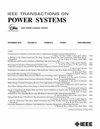配电网中最优开关和配线规划:用快速启发式方法对实用的MILP模型进行基准测试
IF 7.2
1区 工程技术
Q1 ENGINEERING, ELECTRICAL & ELECTRONIC
引用次数: 0
摘要
配电系统规划中,开关和配线的优化布置是一项不可缺少的任务。由于问题的复杂性和二元决策变量的存在,使用启发式方法获得接近最优的开关和连接线规划在工业中是一种常见的做法。使用混合整数线性规划(MILP)来保证解的最优性的努力也倾向于通过过度简化假设来牺牲建模精度,以使问题易于处理。为了应对这些挑战,我们提出了一个高效而准确的MILP模型,用于优化开关和配电网规划。该模型避免了最先进的MILP模型中常见的简化假设,同时保持了求解效率。为了证明该方法的适用性和可扩展性,将其应用于多个测试网络,并与快速启发式模型的结果进行了比较。结果不仅表明了MILP模型的高效率和准确性,而且验证了启发式方法作为商业配电系统规划工具箱模块的实际应用的接近最优性。本文章由计算机程序翻译,如有差异,请以英文原文为准。
Optimal Switch and Tie Line Planning in Distribution Networks: Benchmarking a Practical MILP Model With a Fast Heuristic Approach
Optimal placement of switches and tie lines is an integral task in distribution system planning. Owing to the problem complexity and the presence of binary decision variables, using heuristic methods for obtaining a close to optimal switch and tie line plan is a common practice in industry. Efforts to employ mixed-integer linear programming (MILP) to guarantee the solution optimality also tend to sacrifice the modeling accuracy through oversimplifying assumptions to make the problem tractable. Aiming to tackle these challenges, we present an efficient, yet accurate, MILP model for optimal switch and tie line planning. The proposed model avoids common simplifying assumptions in the state-of-the-art MILP models while preserving the solving efficiency. In order to demonstrate the applicability and scalability of the proposed MILP approach, it is applied to multiple test networks, and the results are compared with those of a fast heuristic model. The outcomes not only represent the high efficiency and accuracy of the MILP model but also validate the close to optimality of the heuristic approach developed for practical applications as a module in a commercial distribution system planning toolbox.
求助全文
通过发布文献求助,成功后即可免费获取论文全文。
去求助
来源期刊

IEEE Transactions on Power Systems
工程技术-工程:电子与电气
CiteScore
15.80
自引率
7.60%
发文量
696
审稿时长
3 months
期刊介绍:
The scope of IEEE Transactions on Power Systems covers the education, analysis, operation, planning, and economics of electric generation, transmission, and distribution systems for general industrial, commercial, public, and domestic consumption, including the interaction with multi-energy carriers. The focus of this transactions is the power system from a systems viewpoint instead of components of the system. It has five (5) key areas within its scope with several technical topics within each area. These areas are: (1) Power Engineering Education, (2) Power System Analysis, Computing, and Economics, (3) Power System Dynamic Performance, (4) Power System Operations, and (5) Power System Planning and Implementation.
 求助内容:
求助内容: 应助结果提醒方式:
应助结果提醒方式:


